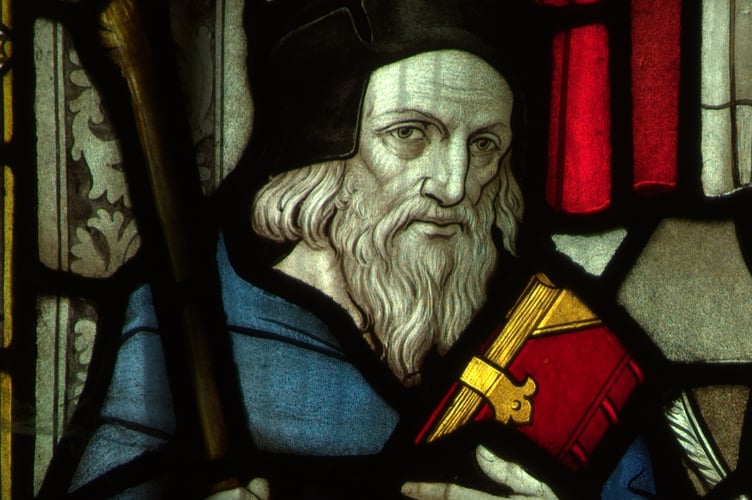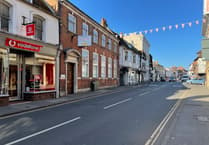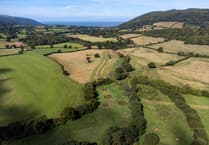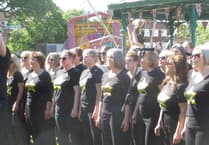Any visitor walking around Farnham today is likely to see it as an attractive, architecturally interesting and, when clear of roadworks, a relatively peaceful market town, writes Derek Carpenter.
The idea of it ever being recognised as a hotbed of religious intrigue, insurrection and iconoclasm seems very difficult to believe. Yet, in the early to mid-15th century, both church and state went even further, placing Farnham as a national centre of heresy and treason. This was a time when the population of the town and the surrounding ‘Farnham Hundred’ barely accounted for one thousand souls in total.
Towards the end of the 14th century in England, an Oxford theologian, John Wycliffe, criticised the wealth and property held by the Catholic Church in light of the poverty that prevailed after the Black Death. He also attacked the role of the clergy and, more dangerously, the Papacy itself.
For Wycliffe, the scriptures contained all the rules and requirements people needed to follow and which, if they were made readable in English and not Latin, would make priests’ selective interpretations unnecessary.
By the time Wycliffe’s teachings took root, the name ‘Lollards’ had become synonymous with his followers. It is a label said to derive from a Dutch word meaning ‘mumblers’, describing those who recited scriptures aloud.
In July 1440, a Farnham weaver, Adam Mulward, and a chaplain from Thursley, William Iryssh, were accused of “treasonously proposing, imagining and conspiring at Thursley to bring about the death of King Henry VI, the destruction of his law and of the whole English church, and the death and destruction of all magnates, nobles and lawyers throughout the realm”.
In addition to these weighty charges, they were said to want the priory of St Mary of Southwick near Portsmouth, and all other religious houses in England, to be deprived of their goods and land, and all their religious images to be taken down and burned. This was nearly a century before Henry VIII followed a similar path, albeit more for personal gain than theological belief.
Their error was to attempt to recruit John Hurlebat of Farnham to their cause. Instead, Hurlebat went to Dogmersfield, to the palace of Bishop Stafford, the Bishop of Bath and Wells, to report the heresy of Mulward and Iryssh. Why he did not make his testimony to Henry Beaufort, the Bishop of Winchester at the time and the episcopal head of the church in Farnham, is not known. Perhaps Beaufort’s whereabouts were unknown or access to him was difficult – or perhaps Hurlebat felt Beaufort would not have given his story the serious response he believed it deserved.
Hurlebat’s report alarmed many at senior levels in the Church and King Henry himself. They feared an uprising in Farnham was being planned.
A commission was quickly convened to establish how widely treason and heresy in Farnham and neighbouring areas had spread. It did not take long for them to expose more followers who shared and promoted the same ideology.
Thomas Smyth, a fuller (someone who cleans newly woven cloth to remove oils and impurities), and John Golle, a barber – both from Farnham – together with six weavers, a tailor and his wife from Farnham and Thursley, were sent to trial for heresy and “holding erroneous opinions of the Catholic Church”.
In addition to following Wycliffe’s general beliefs, they made specific attacks on the role of the clergy, believing that a child born of a Christian man and a Christian woman did not need to be baptised; confessions of sins to priests were unnecessary; no priest had the power to absolve anyone of their sins; and it was not a sin for a man to have carnal knowledge of a woman who was not his wife.
As the perceived sources of this heresy, Adam Mulward and William Iryssh were sent for trial. Mulward refused to implicate any others in the charges he faced and was sentenced to be hanged, disembowelled, his bowels burned and his body quartered.
His head was displayed on a long pole in the centre of Farnham, and parts of his butchered body displayed in Guildford, Alton, Odiham and Kingston – a gruesome warning to others.
Some reports suggested that a few of the other defendants escaped, but The Chronicle of London recorded that other “risers of Fernam”, “some were hangid and some were brent”.
Derek Carpenter is chair of the Farnham Castle Trust





Comments
This article has no comments yet. Be the first to leave a comment.